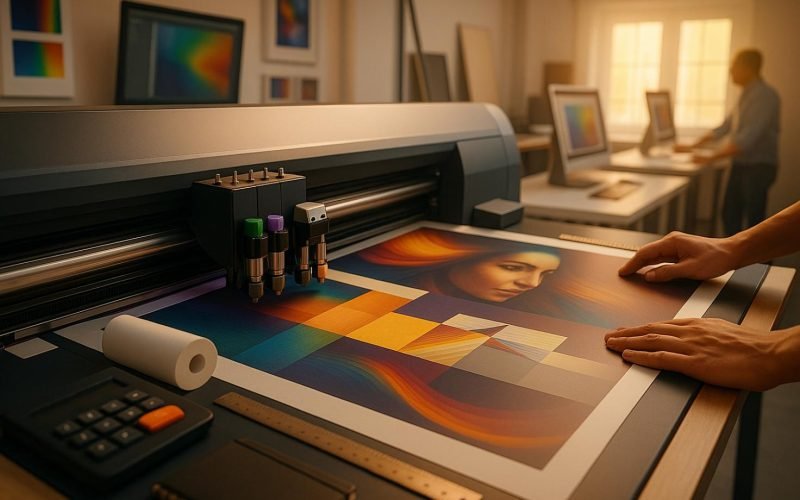Printing and installing stickers of all kinds, stickers are considered important marketing and advertising tools used to attract attention and promote products or services. Whether you want to enhance the appearance of your car, strengthen your brand identity, or add an aesthetic touch to your product, stickers offer a variety of options to meet your needs. In this article, we will cover everything related to printing and installing stickers of various types, focusing on technical, creative aspects, and best practices to achieve desired results.
Types of Stickers and Their Characteristics
Stickers vary depending on their use and the materials used in their production. Below are the most common types:
|
Type
|
Description
|
Main Uses
|
|---|---|---|
|
Car Stickers
|
Made from water-resistant and UV-resistant materials.
|
Car wrapping, mobile advertisements, decoration.
|
|
Window Stickers
|
Transparent or opaque, characterized by easy installation and removal without leaving residue.
|
Shop windows, offices, exhibitions.
|
|
Wall Stickers
|
Made from removable materials, available in multiple designs.
|
Home and office decor, directional signs.
|
|
Product Stickers
|
Small-sized, printed with high color accuracy.
|
Branding products, packaging.
|
|
Floor Stickers
|
Resistant to wear and tear, used in high-traffic areas.
|
Guidance inside stores, airports, exhibitions.
|
Steps for Printing Stickers
The process of printing stickers requires great precision to ensure the quality of the final product. Here are the basic steps:
- Design Selection :
- The design should be clear and aligned with the purpose of the sticker.
- Design software such as Adobe Illustrator or Photoshop can be used to create the sticker.
- Selecting the Appropriate Material :
- The material depends on the use; for example, plastic materials suit outdoor stickers, while paper materials suit indoor uses.
- Selecting the Printer :
- High-quality digital printers are used to print colors accurately.
- Printers that support printing on different materials should be chosen.
- Cutting the Sticker :
- Digital cutting machines are used to cut the sticker precisely into the desired shape.
- Adding a Protective Layer :
- A glossy or matte layer is added to protect the sticker from scratches and environmental factors.
Sticker Installation Process
Installing stickers requires skill and experience to achieve perfect results. Here are the basic steps:
- Surface Cleaning :
- The surface should be thoroughly cleaned using special cleaning agents to remove dust and oils.
- Measuring the Area :
- Measure the area accurately to determine the appropriate installation location.
- Applying the Sticker :
- Apply the sticker slowly onto the surface, ensuring no air bubbles are present.
- Removing Air Bubbles :
- Use a plastic spatula or a special tool to remove air bubbles.
- Final Fixation :
- Ensure the sticker is securely fixed using a strong adhesive material.
Tips to Improve Sticker Quality
To get the best results when printing and installing stickers, follow these tips:
- Choose the Right Design :
- The design should be consistent with the purpose of the sticker, whether it’s advertising or decorative.
- Use High-Quality Materials :
- Poor-quality materials may lead to rapid sticker damage.
- Rely on Professionals :
- If you lack sufficient experience, it’s best to hire a specialized company.
- Choose Colors Carefully :
- Bright colors attract more attention, but they should align with the brand.
- Ensure Environmental Compatibility :
- If the sticker will be used outdoors, it must be weather-resistant.
Advantages of Using Stickers
- Cost-Effectiveness : Stickers are an economical option compared to traditional advertising methods.
- Easy Installation : They can be installed easily, even by individuals without experience.
- Flexibility : They can be designed in various shapes and sizes to meet different needs.
- High Durability : If good materials are used, they can last for years without damage.
Challenges in Printing and Installing Stickers
Despite the many advantages of stickers, there are some challenges you may encounter:
- Dealing with Uneven Surfaces :
- It may be difficult to install stickers on curved or uneven surfaces.
- Environmental Impacts :
- UV rays and humidity may affect sticker quality.
- Sticker Removal :
- Some stickers may leave adhesive residues after removal.
Sticker Printing and Installation Prices
Prices vary depending on several factors, such as the type of material, sticker size, and quality level. Here’s an approximate price estimate:
|
Type
|
Approximate Price (USD/Square Meter)
|
|---|---|
|
Car Stickers
|
10-20
|
|
Window Stickers
|
8-15
|
|
Wall Stickers
|
5-12
|
|
Floor Stickers
|
15-25
|
Conclusion
Printing and installing stickers is a process that requires a combination of artistic skill and practical experience. Whether you’re looking to improve the appearance of your car or enhance your brand, stickers provide innovative and versatile solutions. By following the tips and steps outlined in this article, you can achieve professional results that meet your needs and aspirations.
Remember always that quality and precision are key to obtaining long-lasting stickers that achieve the desired goals. If you need professional help, don’t hesitate to contact specialized companies offering sticker printing and installation services.
 العربية
العربية
